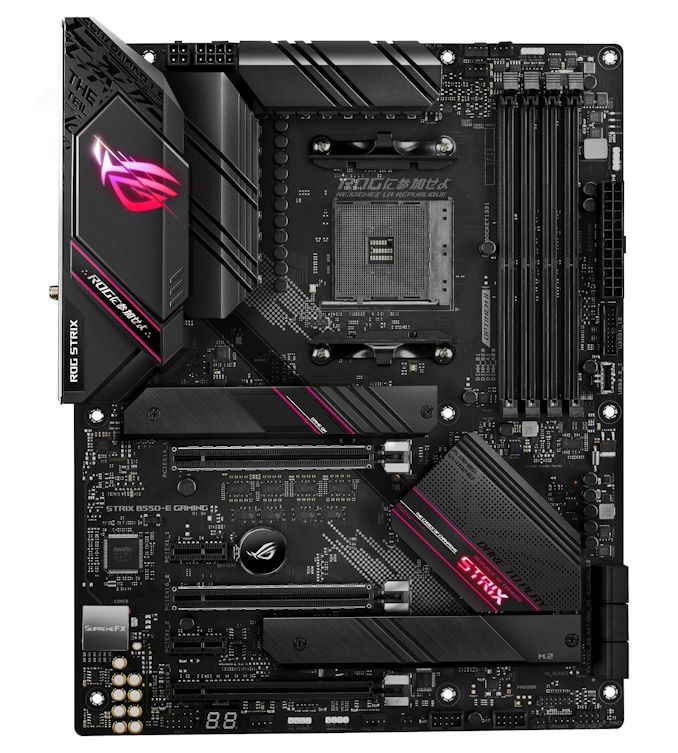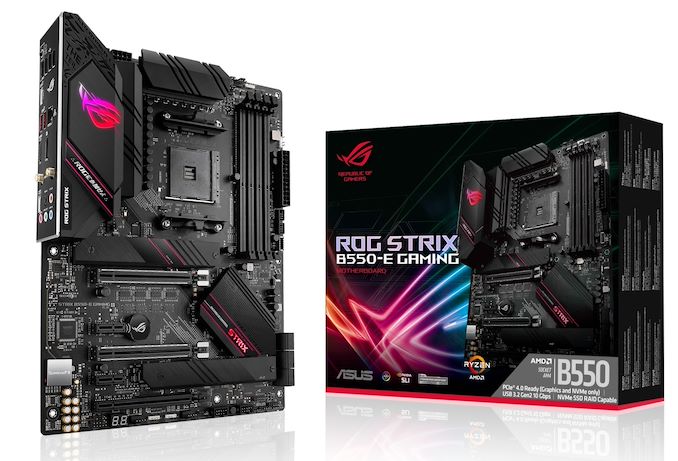The AMD B550 Motherboard Overview: ASUS, GIGABYTE, MSI, ASRock, and Others
by Dr. Ian Cutress & Gavin Bonshor on June 16, 2020 11:00 AM ESTASUS ROG Strix B550-E Gaming
Out of ASUS’ three main sub-brands for B550, the Strix is aimed at the higher end, and we get a range of options to play with. The B550-E Gaming is the more expensive of the bunch, at $280, although it is one of the few boards to offer x8/x8 functionality with its PCIe slots. The use of this configuration isn’t so much for gaming (despite the name), due to lack of SLI support, but it does enable a good setup for a machine based around GPU compute or add-in cards, like RAID cards, or additional PCIe x4 NVMe drives.
ASUS’ design philosophy this time around involves a similar corner to corner 45-degree line scheme to a lot of other different brands, however in parts ASUS pushes this to a more dot-matrix style design. We still get that ROG font on all the words though.
For features, the B550-E Gaming has a large rear panel cover that covers only the rear panel rather than the full audio section, and this covers over the heatsink for the power delivery. There are two heatsinks here, like most boards with high-end power delivery, but there does not seem to be a heatpipe between them for this board.
The socket area has access to four 4-pin fan headers within easy reach, three of which are just above and to the right of the socket. The CPU is powered by an 8-pin and a 4-pin, and the board has four memory slots with single sided latch arrangements. Down the right hand side of the board is a 4-pin LED header, a 24-pin ATX power connector, a USB 3.0 header, a Type-C header, and six SATA ports.
For the PCIe area, as mentioned the two main PCIe slots both come from the CPU, with x16 or x8/x8 connectivity at PCIe 4.0 bandwidth, due to the use of PCIe switches. Both of the main PCIe slots have extra reinforcement, and above the first PCIe slot is a PCIe 4.0 x4 M.2 slot, with its own heatsink. This isn’t connected directly to the chipset heatsink, however the second M.2 slot (a PCIe 3.0 x4 from the chipset) is connected. The final full-length PCIe slot is a PCIe 3.0 x4 from the chipset as well.
Along the bottom of the board is a 2-digit debug, two 4-pin fan headers, two RGB LED headers, two USB 2.0 headers, and the front panel headers. The audio codec on the left, ASUS’ custom S1200A codec, gets the SupremeFX treatment.
On the rear panel there is a 2.5 gigabit Ethernet port (Intel I225-V), a DisplayPort, a HDMI video output, two Type-A USB 3.2 Gen 2 ports, one Type-C USB 3.2 Gen 2 port, four USB 2.0 ports, one USB 2.0 Type-C port for audio, audio jacks, a BIOS Flashback button, and an Intel AX200 Wi-Fi 6 module.













101 Comments
View All Comments
Savikid - Tuesday, August 25, 2020 - link
But the new oculus stuff only uses 1 usb port, so that right there is a drop. I use 2 for keyboard and mouse, one for a wireless controller, and one for my HMD.Gigaplex - Tuesday, June 16, 2020 - link
"On that one I added a USB PCI card to get enough ports."That's not really helpful to the user who said they can't add in a card on their mITX system.
eye4bear - Wednesday, July 1, 2020 - link
Must be nice to have no external hard-drives, I have 3 all needing their own USB 3 port, along with a Logitech dongle that runs both my mouse and keyboard, finally a Bluethooth dongle as my computer has none built-in. Yes I would need 6 USB ports (one open for USB sticks) just to keep even.consolessuck - Friday, November 6, 2020 - link
No, I have 3 usb ports on my laptop and i only use 1 for my mouse. As it turns out, the most amount of usb ports i use at once is two when i am making a wired data transfer with my mouse plugged in. Actually, I almost never transfer data to my phone with a wire, instead just sharing them via bluetooth. and considering i never make large data transfers to my phone, this works out just fine. as for a desktop, however, i'd like a minimum of 3 as i'll always have not only a mouse, but a keyboard plugged in all the time.taz-nz - Thursday, June 18, 2020 - link
The Asrock B550M Steel Legend has 8 port on the back:4x USB-A 3.1 ports
1x USB-A 3.2 port
1x USB-C 3.2 port
2x USB-A 2.0 ports
And you still have two USB 2.0 internal header, plus two USB 3.1 internal headers.
So that allows you to have another
4x USB-A 3.1
4x USB-A 2.0 ports.
so that's 16 Ports
Now if you like me and need Internal USB 3.2 USB-C header, you can use the PCIe 3.0 x2 m.2 slot to add one of these:
https://www.delock.de/produkte/S_63998/merkmale.ht...
or if you want two more USB 3.1 internal header you could add one of these:
https://www.delock.de/produkte/G_62843/merkmale.ht...
So if you can live without a second m.2 slot you have four more USB-A 3.0 ports.
That gives you 20 USB ports without giving up a PCIe slot.
taz-nz - Thursday, June 18, 2020 - link
oops, just noticed you said mITX not mATXdesii - Tuesday, June 16, 2020 - link
Do any of these motherboards support ECC RAM (either buffered or unbuffered)?drSeehas - Wednesday, June 17, 2020 - link
Socket AM4 CPUs support only unbuffered RAM.PixyMisa - Wednesday, June 17, 2020 - link
I did a quick look on ASRock's site, since they're pretty good on ECC support, and every B550 board I checked lists ECC as supported.Samus - Tuesday, June 16, 2020 - link
I think AMD screwed up here with pricing their platforms appropriately. I understand the push for PCIe 4 but they can't have average motherboard prices hovering between $200-$300. There has to be $100 motherboards to be taken seriously especially by OEM's if they want 4000 parts to become mainstream.But maybe they don't...maybe they plan to milk the 3000 parts for a few years. After all, there isn't much reason not too. They have no competition from Intel in the budget segment right now.